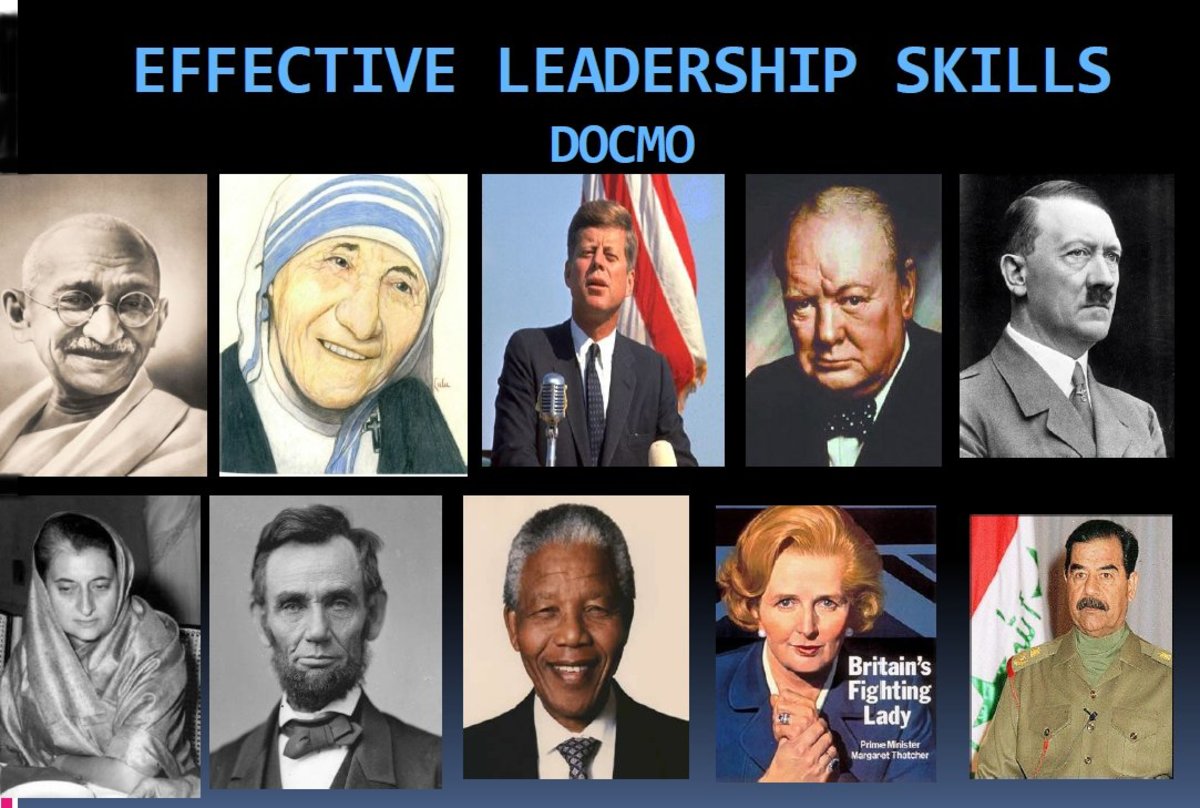Leadership That Works

Giving Workers a Sense of Control
Current Leadership Styles
Although this hub discusses leadership styles common in business situations, these principles can apply to any type of leadership----families, social groups or clubs, and community projects. As you read about the different kinds of leadership styles, see which one you would probably use in various situations in your own life.
Business Leadership
Businesses today are all about making money. To be an effective company and remain in the black, leaders should possess certain qualities. These leaders can guide the company in a resourceful manner so that the company makes a profit and continues to grow. For that to happen, the leadership must gain the trust and respect of the employees, the clients, and the general public. In other words, effective leaders help an organization achieve success.
The word leadership has a number of definitions, which may vary depending on the particular time in history and the theoretical views of those who define leadership in each situation. A rather basic definition is simply one who guides. However, leadership has evolved over the years, each particular style of leadership has its own definition.
Management
A companion to leadership is management. These two terms are synonymous and are inextricably linked together in the day to day operation of a business. Management is the manner in which the leaders of an organization take action or guide the members of that organization. E.S. George defines management as “it is getting things done through others.” He gives another definition, “It is the process of designing and maintaining an environment in which individuals working together in groups efficiently accomplish selected aims” (George, 2012).
The roles of leadership and management have changed over the years. A close look at how leadership roles have changed and evolved over the years from the 19th century until today reveals the interconnections between management and leadership over time, similar to opposite sides of a coin. Just as leadership’s roles have changed over the years, the role of management has evolved. A close analysis of management evolvement indicates that the progression from one era to another is not always linear. Some overlapping in philosophy occurs from one time to another.
Current Trends in Leadership
Generally, the trend in leadership has meant that leaders usually try to involve the subordinates in decision-making and give workers the feeling that they have some control over their lives while at work. The move seems to be to go from autocratic and demanding of workers to a more liberal, democratic approach, one that involves the workers as much as possible. A variety of leadership styles are used today. One group of leadership styles is related to the contingency theories, which are commonly practiced today because these leadership styles are more efficient than many of the past styles. Although many styles may be chosen, the contingent theories have been rather common in business circles today. The language may be technical, but the following explanations of several contingent theories should prove helpful.
The Three Contingent Styles of Leadership
For a number of years, leadership trends have focused more on a team approach that gives employees some say in the operation of the business rather than away an autocratic style of leadership. The trend toward more democratic leadership style allows employees to take a more active role in collaborating with the company’s leaders and management. One such leadership style is the contingency style or contingency theory.
The contingency style is one that allows leaders to adapt the decisions according to each situation. In general, a definition of contingency theories can be “using the right style in the right situation to succeed” (Lussier & Achua, 2010). Three major contingent styles of leadership are predominant in business today. Robert House’s Path Goal theory (1971), the Vroom and Yetton Normative Model (1973), and the Paul Hersey and Kenneth Blanchard’s situational leadership theory (1988) are three contingent styles. They are generally similar in that they possess the characteristics of contingent leadership. However, noticeable differences are also apparent among the three theories. The following situations are examples of the various types of contingency leadership theories.
1. Path-Goal Style
One contingency style is the Path-Goal theory. Robert House is responsible for development of this theory. It is somewhat limited in the breadth and scope of its usefulness. It focuses rather narrowly on the role of leadership in helping followers reach their work goals. The efficiency of the path-goal theory depends on the tasks performed by the subordinates (lessons, legacy) and relates to a narrow area of the leader-follower role, the leader helping the follower achieve his goals, thus attaining satisfaction. House’s four styles of leadership, directive, supportive, participative, and achievement oriented, range from the most restrictive, directive, to achievement oriented, which allows the most freedom to followers in decision-making. Thus, the path-goal leadership is more limited than the other two theories because it focuses mostly on task and person-oriented behavior and largely ignores cognitive orientation with respect to motivation and other variables of the leader-follower roles within an organization.
2. Vroom-Yetton Style
Next, the Vroom-Yetton model provides more depth, particularly regarding the extent to which leaders allow followers to participate in the decision-making process. The Vroom-Yetton model further differentiates various levels within the categories of styles, thus allowing the leader more flexibility in various situations than does the House model. The Vroom-Yetton model does not, however, provide the flexibility for numerous situations that the Blanchard model does. The Vroom-Yetton model identifies five different leadership styles, and they are similar to those in the House model. As an example of the similarity between the House and Vroom-Yettman model, the most restrictive step is Autocratic Type 1 (A1), and House names his most restrictive leadership stage, directive. However, the Vroom-Yettman mode is more detailed than House’s model, and the Vroom-Yettson model breaks each leadership style into two components, for example, Type I (CI) and Consultive Type II (CII).
One of the functions of leadership is decision-making. The Vroom and Yetton Normative Model deals with how leaders make decisions and the extent to which the leaders allow followers to participate in the decision-making process. The decision to take followers from their regular jobs to participate in the decision making process can be costly; therefore, leaders should make this decision only after careful consideration (Vroom, V.H. & Jago, A.G. 1988). This model requires that the leader diagnose a particular problem and determine how the quality of the decision could be affected by the followers’ involvement in that process (Lunenburg, While this model offers more flexibility than House’s model, the Vroom-Yetton model has problems with regard to the testing of the theory.
The problems with studies that test the validity of the model have been both internal and external validity issues. One internal problem in validating this theory has been that the data reported by participating managers was self-reported data. The self-reporting factor means that it is possible that managers reported having success with their decision-making regardless of their actual behavior. In other words, the data reported by the managers could have been cognitively distorted, which would render the study invalid. An additional problem with external validity is that the model may not provide a good fit with real-life problem solving situations, partly because Vroom and Yetton developed the model using standardized cases and self-reported decisions (Field, 2001). However, a study by Field and Andrews (1998) indicated positive results after testing the theory with managers in a study to account for more variance in decision effectiveness than the prior Vroom and Yetton model. The findings indicated that the Vroom and Jago model had greater precision in situational assessment and derived prescriptions allow for greater discrimination in choice of decision method across all situations. (5 1998 John Wiley & Sons, Ltd).
The Path-Goal theory does not allow for nearly as many different variables, and that is one of the main differences between the two models. The Vroom-Yetton model is more complex than House’s path-goal theory and provides more levels for decision-making with leaders and groups, allowing for a few more variables than the path-goal theory. However, the Vroom-Yetton model is not as comprehensive or as detailed as the Hersey-Blanchard theory, which provides eight questions that leaders can ask to facilitate in tailoring the decisions to each particular situation.
3. Hersey-Blanchard Style
Finally, the Hersey-Blanchard theory (1988) reflects the development of a multifaceted leadership model of situational leadership. The essence of this theory is the idea that no particular “best” style of leadership exists----the style is relevant to the task. One of the strongest assets of this model is that it allows for the many variables possible within different situations with individuals of varying levels of maturity and motivation. It espouses the view that effective leaders adapt their leadership styles to the efficiency and maturity of the group they are leading and to the tasks. In considering all these factors---the followers, with all the possible variances, and the task, with all the variables possible within the task, the effective leader makes the best decision with all these factors in mind. It is important to note that this leadership style is more prevalent with more recent management, who more often tend to view the organization as a whole, rather than focus on only one component, for example, task completion.
Conclusion
Of the three contingent styles, the Hersey-Blanchard theory is the least restrictive and gives the workers more control over decision-making. The trend in recent years has been toward less autocratic styles of leadership; therefore, contingent styles have been the leadership style of choice more than ever. The result is that subordinates feel they have more control over their lives at work, which research reveals to be a key factor in employee satisfaction.






